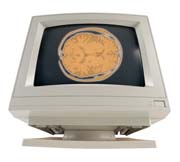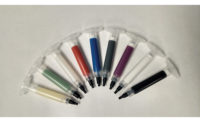
To illustrate this point, we retrieved over 15,000 rubber compositions from the public domain, none of which is proprietary. We stored them in an Excel spreadsheet, saved in such a format that a state-of-the-art Machine Intelligence (MI), previously known as Artificial Intelligence (AI), software can read.
Such a database can come from your own historical data and be stored on a PC for personal use or on a server or mainframe for others to use. The MI software can identify and quantify each input contribution to an output, which is not always so obvious, so the user can exclude inputs with low contribution; once the MI converges, it can create a *.DLL file that the user can link to the original Excel spreadsheet to play a very intelligent "what-if." Using another software algorithm that can be linked to Excel (which explores all potential input combinations to achieve an output) can generate compositions that the user might not have considered. A graphic program implemented in Excel can plot results in multiple dimensions to help visualize the results.
One can set outputs such as cost, hardness, tensile, or a process condition, ask the computer to generate as many compositions as possible that would meet the set output, prepare what the system suggests, and then test it by entering the compositions suggested by the system and their measured outputs (cost, hardness, tensile, etc.) into the original database. If none of these compositions meets the user's criteria, the same exercise can be repeated. The system will then ignore the same space in which the compositions did not meet the desired goal - that is, the MI learns from its mistake if given the appropriate constraints. We have found that performing this exercise 2 to 4 times produces a composition with the most desirable outputs in the least amount of time at the lowest cost.
As new formulations are created or updated and placed in the public domain, they could be added to the database as well. The MI software relies highly on a database, which could be historical data, or data acquired from the public domain, technical literature, technical reports, design of experiment, examples cited in patents (as long as what is taught in a patent is not used as taught to benefit anyone other than the inventor or the patent assignee), etc.
The MI system is made up of various modules that have to communicate efficiently for the system to work; any of these modules can be updated as needed. The utility of such system has been limited by personal computer storage space. The more historical the data, the better, which can require large amounts of hard-drive space. Convergence of the MI software is dependent on the ability of the PC to number crunch, but as the price of hard-drive storage decreases and the computer's ability to execute instruction/second increases, PC capability has also increased.
Such a system designed to take advantage of the best parts of various types of software, such as the interactive ability of Excel, the ability of the MI software to quantify inputs, and converge to a usable model, that could be linked back to Excel, allowing a user to play an intelligent "what-if," or allow the system to make suggestion as to what will meet the user criteria.
This system is a significant step further than design of experiments, where an experiment is developed with the aid of a statistician, performed by a formulator who accumulates output data, and analyzed by a statistician, which may or may not lead to optimum, maximum or minimum results.
Expert systems are designed by knowledge engineers, with the aid of someone well versed in the knowledge domain, by forming "if-then-else" rules. Mostly used in diagnosis, these rules can also be implemented by applying appropriate software to an Excel spreadsheet. They can be very helpful when used in combination with an MI system, especially when the expert system is capable of backward propagation. An expert system could also be used to identify the best type of adhesive for an application, and the most likely adhesive composition to meet the user criteria, using forward or backward propagation. An AI system with the constraints of an expert system, with backward and forward propagation, is both ideal and realistic.
About R&D Technology International Inc.
Michael W. Rouse and Victor M. Deeb founded Rouse & Deeb Technology Inc. in 1995 to provide companies with practical solutions to difficult R&D problems using MI technology.
Victor M. Deeb received his chemistry/computer degree from Kent State University and has over 40 years of industrial experience. For more information, visit members.aol.com/vmdeeb/index.html or e-mail vmdeeb@rcn.com.


